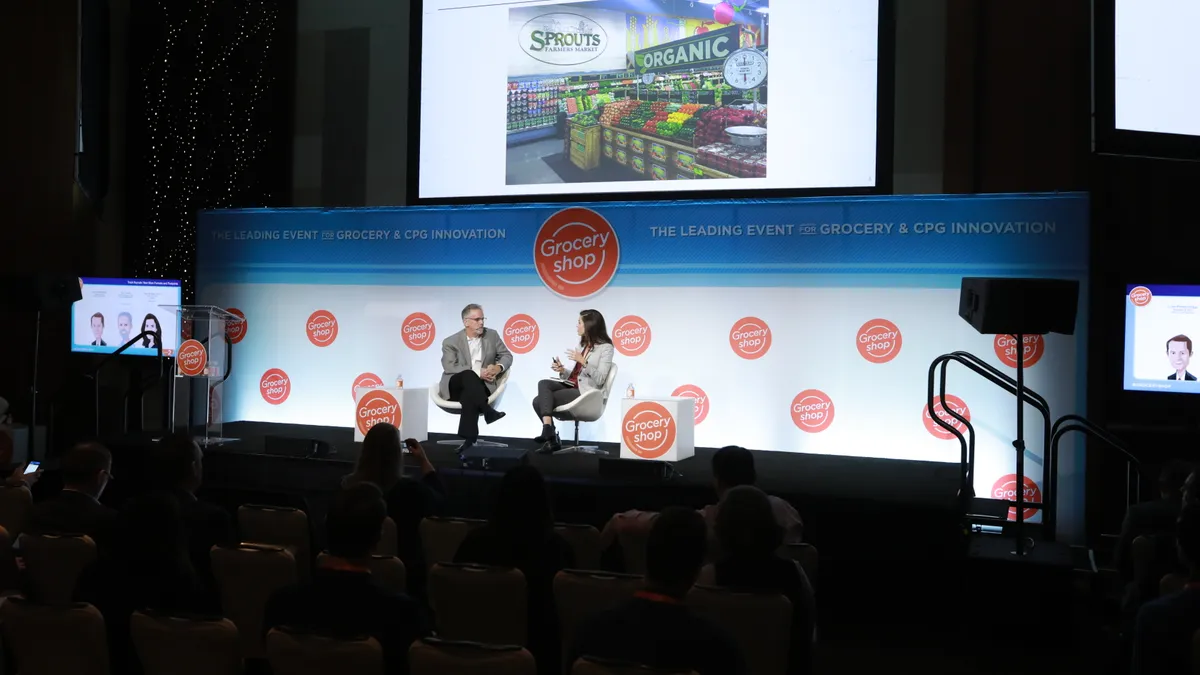LAS VEGAS — Gone are the days of grocers growing in size to drive high-volume sales of packaged goods. These days, grocers are reducing their store size and cutting out the middle aisles to deliver fast, healthy foods that serve convenience-seeking and time-restricted consumers.
The perimeter of the store is growing 3% to 5% while center store is shrinking, said Luke Petherbridge, president and CEO of Shopcore Properties, a real estate firm, during a presentation at Groceryshop. Meanwhile, overall store size has shrunk 20% since the beginning of the 21st century while productivity has flourished. The average gross sales at grocery stores is $350,000, Petherbridge said.
"If you overlay that with the shrinking format, the total productivity is up 20-30% in the last eight years and this gives us comfort," said Petherbridge.
The center aisle, however, is where the bulk of traditional grocer's products come from, causing distress across the retail and packaged goods industry, said Rachel Wein, founder and president of WeinPlus, a Florida-based commercial real estate strategy firm.
Sprouts Farmers Market is one grocer that's found a way to invert the traditional grocery model, placing produce in the middle of the store and creating what chief development officer Ted Frumkin calls "connectivity between the customer and the products." Produce, much of it organic and priced lower than competing stores, comprises of about 15% of the store footprint and 23% of sales, he said.
Recently, Sprouts made some changes to its legacy store format that brought forward fresh, prepared foods like sushi, baked goods and deli sandwiches while moving preparation to the back. The move came after customers complained about workers prioritizing food prep over service, said Frumkin.
This new format debuted in January in Arizona, and five more opened throughout this year, Frumkin added. The grocer plans to add nine to 10 more by next year and come 2020, expects all stores to be renovated into this new format. Frumkin says Sprouts embraced the small-format stores from the beginning, with most coming in at around 28,000 square feet.
"I think we’re seeing 1.6 million customers a week in our stores," he said, noting that customers are spending more time around meals. "That format, we believe is the way the grocery industry is going to head," said Frumkin.
From Aldi to Amazon Go, retailers across the country are focused on small, high-productivity stores that capitalize on consumer demands. According to Nielsen, 25% of fast-moving consumer goods sales come through small stores, while 70% of shopping trips go to these locations.
Increasingly, scaling down for retailers means opening specialty standalone markets similar to Hy-Vee's HealthMarket store or Target's newest small-format store in urban, suburban and college cities. Target is slated to unveil 30 of its small-format stores in urban, suburban and college cities by the end of the year and have 130 by the end of 2019. Hy-Vee's new market is around 15,000 square feet, focuses on healthy and organic products and includes a pharmacy, medical clinic, sports nutrition, and access to an OrangeTheory gym next door.
While most grocers are scaling down, a select few, like H-E-B have found the benefits in scaling up. For the past few years, H-E-B has been steadily opening multi-level markets, most recently in Houston. The layout gives grocers the ability to reside in large cities by scaling up, not out. The grocery store features a public art experience, a shopping cart escalator, a coffee shop, eatery, wine and beer tasting and indoor and outdoor seating.
Still, scaling down is more cost-efficient for grocers especially as e-commerce becomes more prevalent in the grocery industry, according to multiple experts at Groceryshop. If done correctly, it can also provide a simple-but-effective in-store experience for consumers.
“We believe that is the ideal layout in size for customers," Frumkin said about the new enhanced Sprouts store format. "It’s convenient, easy to shop, the average customers in our store spend about 15 to 20 minutes shopping and basket sizes are small."

















